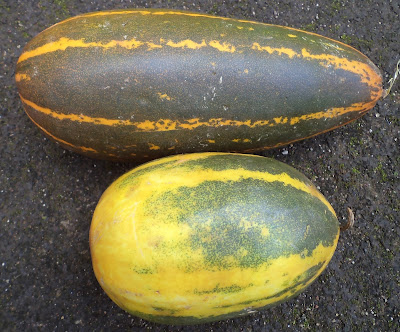AMBYA UMMAN
A SWEET KONKANI RIPE WILD MANGO
SOUPY CURRY DESSERT
Introduction:
Since time
immemorial, huge mango trees have been growing all over the plains, foothills
and plateaus of India. In summer, these trees produce luscious mangoes in great
abundance, shedding the ripe fruit every day on the ground. The birds, squirrels
and bats feed to their hearts content but they are able to polish off only a
portion of the bounty, leaving the rest for humans to enjoy.
These wild
mangoes, unlike the hybrid commercial cultivars, are generally smaller in size,
have fibrous pulp and pack a punch in terms of flavor. It is these wild mangoes
that the Konkani people love to turn into delicious, lip smacking ambya umman.
Some of the
smallest varieties are just a trifle bigger than a lime, have thinner skin, are
lemon yellow inside and have indefatigable flavor. Alas! Man’s greed for
valuable timber has resulted in the loss of a great many of these centuries old
patriarchs among mango trees.
Ambya umman is served
as a dessert in most Konkani feasts during the mango season. Even little children
can be seen joyously tucking away 5 or 6 mangoes at a sitting. I am sure you
too will love ambya umman.
Ingredients:
1) Fully ripe
wild mangoes – 2 Kg.
2) Jaggery (unrefined
cane sugar) – 400 gm.
3) Sugar – 1 tablespoon
4) Salt – 1¼ teaspoon
5) Dry hot red
chilies – 6 Nos.
6) Curry leaves
– 2 sprigs
7) Mustard seeds
– ½ teaspoon
8) Fenugreek seeds
– ½ teaspoon
9) Urad dal
(split black gram lentils) – 1 teaspoon
10) Coconut oil – 2 teaspoons
11) Rice powder or corn starch – 1 tablespoon
To Cook:
Wash the mangoes nicely. If any sticky grime is present,
immerse in a solution of 20 ml. of vinegar in a litre of water for 5 minutes. Scrub
and wash. Rinse in clear water. Pull off the mango peel with your fingers and
set the peel aside in a bowl. Put the peeled mangoes into a pan or any other
cooking vessel.
Pour a couple of glasses of water over the mango peel in the
bowl and squeeze nicely with your fingers to release the flavor from the peel. Pour
the peel juice (after discarding the peel) over the mangoes and set the vessel
on high heat. Tip in the salt. As soon as it comes to a boil, lower the heat
and cook till the mangoes become soft.
Meanwhile, put the jaggery and the sugar into a pan. Pour in
100 ml. of water and set on low heat. Stir till the jaggery is fully melted. The
mangoes must have cooked by now. Sieve the melted jaggery and tip it in. stir
nicely and turn up the heat. Let the curry boil for 4 minutes. Mix the rice
powder or the cornstarch vigorously with 100 ml. of cool water and tip it in. Stir
for a minute or two for the curry to thicken and then switch off the heat.
Break each red chili into 2 or 3 pieces. Pull the curry
leaves off their sprigs and set aside. Set a small pan on low heat. Pour in the
coconut oil and throw in the mustard seeds. As soon as the mustard seeds are
about to finish crackling, tip in the urad dal. Stir till it turns a light
brown in colour. Now tip in the fenugreek seeds. Stir twice and chuck in the broken
red chilies and the curry leaves. Stir twice or thrice and tip over the entire
contents of the pan into the mango curry. Stir and cover with a lid.
Your ultra-delicious ambya
umman is ready to serve. Serve hot or cold either by itself or as welcome
dessert to a meal. Bite in to the juicy flesh of the mangoes. Dip the fibrous
mango stone in the curry sauce and suck it in together with the flesh sticking
to the fibres. Repeat again and again. You are in heaven! Do try this recipe
for sure!!!
Notes:
1)
If wild
mangoes are not available, simply use any other mango. Larger unpeeled mangoes
can be cut to pieces and used. Tangy mangoes are great for this curry.
2)
You can
adjust the quantity of jaggery and sugar to suit your taste.
3)
Rice powder
is used as the thickener in the traditional recipes. However, you will find
that corn starch (or corn flour as it is called in India) does just as well or
even better.
4)
The peel juice
enhances the flavor of the ambya umman.
5)
Please do not
serve tiny mangoes to smaller kids to avoid the danger of suffocating on the
stones.






















